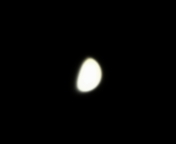iPhone Venus; Quasar CTA 102 Observing
Posted: 18 December 2016
Cloudy skies continued until Saturday afternoon, 17 December 2016. Got some rain (0.08") on Friday, 16 December, and then more rain (0.89") early Saturday morning. I checked the POD; there was one minor leak at the bottom of the primary dome. No damage. Apparently a bolt was loose; I tightened it.
|
Open: Saturday, 17 December 2016, 1715 MST Temperature: 58°F |
Session: 1053 Conditions: Clear, hazy |
Equipment Used:
12" f/8 LX600 w/StarLock
Wired AutoStar II handset
2" 24mm UWA eyepiece
2" 9mm 100° eyepiece
1.25" 9mm eyepiece
Camera:
iPhone 6s Plus
As I approached the observatory shortly before sunset, Venus was visible high in the southwestern sky.
1720 MST: sunset.
1721 MST: LX600 ON, StarLock OFF, High Precision OFF.
1725 MST: viewed Venus, 102X and 271X. The view was pretty good of the near half lit planet.
Switched from the 2" 9mm eyepiece to a 1.25" 9mm eyepiece. Mounted the iPhone 6s Plus on the 12" telescope using the Levenhuk Smartphone Adapter. Did a couple of slo-mo videos (10 seconds, 240 fps) of Venus, afocal 271X. This is a stack of one video (2472 frames) using Keith's Image Stacker:

1740 MST: removed the iPhone and switched back to the 2" 24mm UWA eyepiece (102X). Viewed Mercury, low and through a tree, 102X and 271X. It was less than half lit. No imaging attempted due to its low altitude in the sky. Returned to Venus for some observing, 271X.
1750 MST: Wi-Fi ON. Did some ScopeBoss iOS app tests for the developer. 1803 MST: tests completed.
Slewed to the star Altair and SYNCed the AutoStar.
1805 MST: viewed Mars, 102X.
1811 MST: began preparations to try to observe Quasar CTA 102, discussed in this Sky & Telescope article, using a magnification of 102X. I first slewed to the star HD212989 and then began "star-hopping" using the chart in the Sky & Telescope article. As Astronomical Twilight ended (1849 MST) I was able to positively confirm that I was viewing the proper area. 1855 MST: after lots of star patterns comparisons I finally decided I was observing Quasar CTA 102. I believe it was about Magnitude +15-ish.
1902 MST: viewed NGC660 (polar-ring galaxy), 102X. Good view. I had imaged NGC660 using the 8" telescope in January 2013 and plan to image it with the 12" telescope on a future session.
1915 MST: did some tests of a new beta of the Dark Sky Meter iOS app for the developer.
1920 MST: as I would have a long day the next day at the "Dark Skies Celestial Concert", a joint event of the Oracle Piano Society and the Oracle Dark Skies Committee, I decided to end this session.
|
Close: Saturday, 17 December 2016, 1931 MST Temperature: 39°F |
Session Length: 2h 16m Conditions: Clear |
Comments are welcome using Email. Twitter users can use the button below to tweet this report to your followers. Thanks.
Cassiopeia Observatory Home Page
Copyright ©2016 Michael L. Weasner / mweasner@me.com
URL = http://www.weasner.com/co/Reports/2016/12/17/index.html
